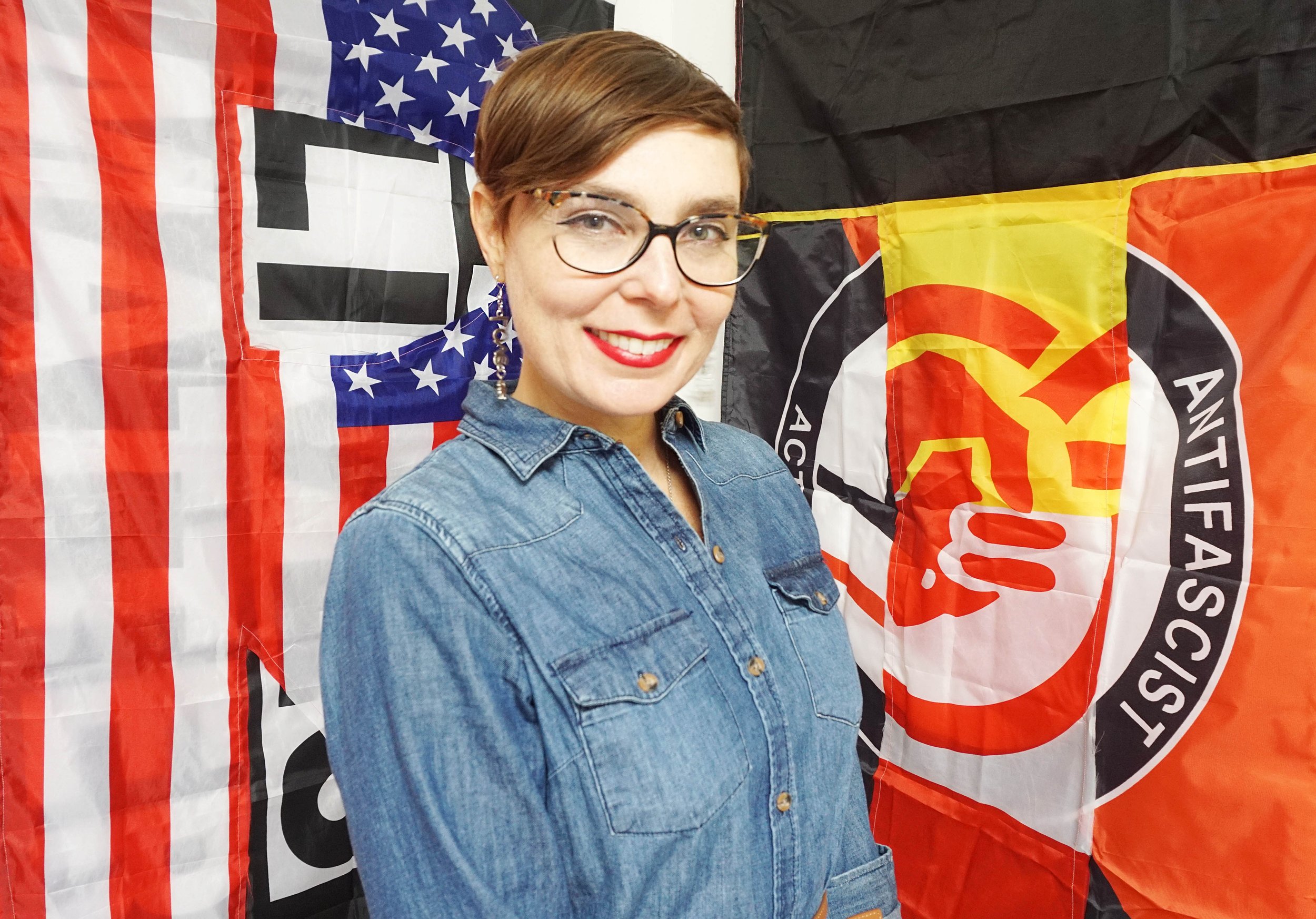What was possible to say
by Michaela Blanc
Julia Csekö’s work reminds us of what it means to approach the visual arts as a form of education and social engagement. As a multidisciplinary artist, her practice embraces painting, sculpture, video performance, installation, and most recently, printmaking to comment on social, cultural, and political issues. The serial nature of her artistry allows for exploration and progression. Her Brazilian-American identity informs how she understands symbols of national pride in both countries. For example, words, flags, ribbons, kitchen utensils, food, and heart representations, recur in her work.
Portrait of Julia Csekö. Courtesy of the artist.
Csekö’s studio practice and creative thought unfold in the series Speaking Truth to Power. An ode to the literary world, her text-based paintings pay tribute to writers, activists, and political and community leaders, such as Diane di Prima, bell hooks, Roxanne Dunbar-Ortiz, Hannah Arendt, and John Lewis to respond to contemporary issues through mathematically-structured color schemes. Each project starts after she reads a book or public statement. The subsequent phase is staged at the artist's studio where she selects an excerpt, calculates letter sizes and surface space, and then finally shifts to the bi-dimensional panel. The topics in these paintings are as varied as their colors. The title of the series is indicative of Csekö's work in solidarity with social justice movements. For instance, influential Brazilian educator Paulo Freire,1 whose radical pedagogies transformed educational methodologies in underserved areas in Brazil and beyond, is referenced in one of her schemes.
1 Freire’s Pedagogy of the Oppressed (1968), one of the 25 most cited publications according to Google Scholar, delves into.
Julia Csekö looking at the silkscreen print of Csekö checking the silkscreen prints of the Speaking Truth to Power series, words by Paulo Freire. Photo Credit: Beacon Gallery.
Over the past few years, Csekö has been commissioned to paint public murals around Greater Boston-area repeating the processual character of her Speaking Truth to Power canvases. Unquestionably, Csekö develops her Speaking Truth to Power series out of her affective memories of Rio de Janeiro. For its aesthetic and humane purposes, her series evokes messages left by the Gentileza prophet — a popular figure from the 1980s, who left inscriptions in a singular lettering work on the city’s overpass columns. For example, his sentence: Gentileza gera gentileza (Kindness Generates Kindness) became a well-known carioca2jargon. The writings of Gentileza are still resonating with passersby every day. What better place than in the city and its enduring communities to learn about the relationship between art and life? Despite Gentileza being a direct influence in Csekö’s work, her paintings convey a broader connection with collective and personal stories by emphasizing statements created to repair cultural and historical erasures, political violence, and environmental damage.
2 Carioca is a person who was born in or who lives in Rio de Janeiro, Brazil.
An example of Csekö's public murals. Courtesy of the artist.
In This is where my heart is (2023), the artist repurposes her heart-shaped soft sculptures to comment on gift-giving and alternative economic arrangements — other than market-based transactions. The heart sculptures in pink to red plush and velvet are individually mounted on small-sized canvases coated with textiles in myriad pop designs, individual pieces show animal prints, tie-dye, and metallic tons. This is where my heart is pieces are meant to be placed on the wall surrounding birthday bunting-like flags with the phrase Post Capitalist Dreams printed on them. The wall-based series was derived from a previous art installation consisting of a hanging structure full of these hearts — which resembles a ripe banana bunch hanging from a tree. Its first iteration was presented to the public in the solo show You/Me(Você/Eu) in Csekö’s hometown of Rio de Janeiro. The public was invited to take an object of sentimental value — a dog leash, a child's drawing, dolls, jewelry, and books — and leave it at the gallery in exchange for a heart. At a given time, the exhibition space was populated by objects brought by visitors. Object by object and memory by memory, You/Me became Julia Csekö’s museum of kindness. Csekö’s humorous critique of market-induced inequalities, which can restrain how we access goods and services, invokes a logic of affection before monetary value.
Csekö' and her plush hearts. Photo Credit: Photo Credit Joana Traub Csekö
The artist’s interest in 3D objects and installations can be traced back to her undergraduate years at the Federal University of Rio de Janeiro, and later as an MFA student in the SMFA at Tufts University, where she graduated in sculpture. In Pauca Paucis, Csekö elaborates on the functionality of kitchen utensils by producing collective eating devices that challenge the individual act of food consumption. For instance, the material presence of a long table covered in red cloth with no chairs or dinner set or individual sitting signals that everyone should be welcome to enjoy the feast. Yet, not everybody is.
Julia Csekö, Pauca Paucis Still. Image credit: Aaron John Bourque.
— My performances are inspired by the notion of the ancient Greek Agora, where performer and viewer, creation and consumption occupy the same space. — JC
In the video performance — that evolved from the installation — 20 performers, dressed in formal attire, devour a banquet that lasted four hours in a critique of class inequalities channeling a materialistic presence. It continued until it reached a point of collective exhaustion. Csekö’s visual narrative touches on how societal structures concede, and often determine, generational overabundance or resource deprivation depending on the social hierarchy of wealth accumulation.
Julia Csekö, Pauca Paucis Still. Image credit: Aaron John Bourque
“What was possible to say was already in print on a banner that repeated a couple of promises from the Declaration of Independence,” says a fragment from Toni Morrison’s Jazz . Csekö’s oeuvre acknowledges enjoyment and experimentation, and it places you where Carnaval meets Boston's Fourth of July.
Michaela Blanc (ela/she/hers) is a Brazilian contemporary art researcher based in Cambridge, MA. She works across archives and museum collections investigating diverse issues. Currently, she is the Wikimedian in Residence at Pérez Art Museum Miami (PAMM); Curatorial Fellow in Contemporary Art at MassArt Art Museum (MAAM); and the Art+Feminism Regional Ambassador for New York and Brazil. She holds an MA in Museum Studies/Education from Tufts University and a BA in Art History from the Federal University of Rio de Janeiro.







